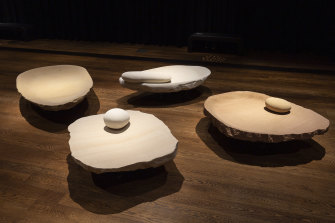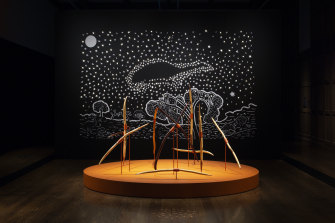
VISUAL ART
Emu Sky
Old Quad, The University of Melbourne, until 21 August
I was spellbound by the grindstones created by Jonathan Jones in collaboration with Uncle Stan Grant in an exhibition at Melbourne University called Emu Sky.

Untitled walam-wunga galang (grindstones) by Jonathan Jones with Dr Uncle Stan Grant Snr.Credit:Christian Capurro
They initially look like abstract modern art — the kind of thing that was meant to look archaic — until you realise that they’re scaled-up versions of equipment used for milling grain many millennia before the Mediterranean civilisations. An engaging soundtrack by the artist explains how First Nations people collected grain, ground it and baked bread.
The sculptural installation that magnifies the forms of mortar and millstone is close enough in scale to evoke an archaeological relic but far enough to prevent you from interpreting it literally.
This balance is important. The aim of the show isn’t to tell us that Indigenous food technologies were similar to ancient Mediterranean practices; the moment people make these comparisons, they set up a yardstick that measures First Nations technologies against industrial advancements elsewhere.
As Aurora Milroy says in an essay for the show, “one of my greatest concerns about the growing interest in Indigenous knowledges is that they will only be recognised when they can be verified through western frameworks”.

Uncle Badger Bates ‘Karnka (digging sticks)’ and ‘Emu Sky’ (background).Credit:Christian Capurro
Instead, the exhibition helps you see things the other way. A symbol of this reversal arises in the image that gives the show its title, Emu Sky, a linocut by Badger Bates from 2008, which is reproduced as a mural. Much of the field is taken up with stars, which we tend to read as luminaries in the sky. But as Milroy observes, the image is “formed not by the stars, but by the dark space between them. It reminds us that there is meaning in the dark or unseen spaces, but to see it, we must cast off the constricted frameworks of western knowledge systems which look only for the light.”
I think of ancient baking practice the same way. The big difference is not in the way Europeans or Africans harvest their grain or leaven their dough or heat it. There would have been counterparts to those processes in Australia.









 Add Category
Add Category